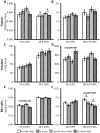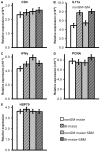Bt-maize (MON810) and non-GM soybean meal in diets for Atlantic salmon (Salmo salar L.) juveniles--impact on survival, growth performance, development, digestive function, and transcriptional expression of intestinal immune and stress responses
- PMID: 24923786
- PMCID: PMC4055707
- DOI: 10.1371/journal.pone.0099932
Bt-maize (MON810) and non-GM soybean meal in diets for Atlantic salmon (Salmo salar L.) juveniles--impact on survival, growth performance, development, digestive function, and transcriptional expression of intestinal immune and stress responses
Abstract
Responses in Atlantic salmon (Salmo salar L.) juveniles (fry) fed diets containing genetically modified maize (Bt-maize, MON810) expressing Cry1Ab protein from first-feeding were investigated during a 99-day feeding trial. Four experimental diets were made; each diet contained ∼20% maize, either Bt-maize or its near-isogenic maternal line (non-GM maize). One pair was fishmeal-based while the other pair included standard (extracted) soybean meal (SBM; 16.7% inclusion level), with the intention of investigating responses to the maize varieties in healthy fish as well as in immunologically challenged fish with SBM-induced distal intestinal inflammation, respectively. Three replicate tanks of fry (0.17±0.01 g; initial mean weight ± SEM) were fed one of the four diets and samples were taken on days 15, 36, 48 and 99. Survival, growth performance, whole body composition, digestive function, morphology of intestine, liver and skeleton, and mRNA expression of some immune and stress response parameters in the distal intestine were evaluated. After 99 days of feeding, survival was enhanced and the intended SBM-induced inflammatory response in the distal intestine of the two groups of SBM-fed fish was absent, indicating that the juvenile salmon were tolerant to SBM. Mortality, growth performance and body composition were similar in fish fed the two maize varieties. The Bt-maize fed fish, however, displayed minor but significantly decreased digestive enzyme activities of leucine aminopeptidase and maltase, as well as decreased concentration of gut bile salts, but significantly increased amylase activity at some sampling points. Histomorphological, radiographic and mRNA expression evaluations did not reveal any biologically relevant effects of Bt-maize in the gastrointestinal tract, liver or skeleton. The results suggest that the Cry1Ab protein or other compositional differences in GM Bt-maize may cause minor alterations in intestinal responses in juvenile salmon, but without affecting overall survival, growth performance, development or health.
Conflict of interest statement
Figures





Similar articles
-
Effects of oral Bt-maize (MON810) exposure on growth and health parameters in normal and sensitised Atlantic salmon, Salmo salar L.Br J Nutr. 2013 Apr 28;109(8):1408-23. doi: 10.1017/S000711451200325X. Epub 2012 Nov 27. Br J Nutr. 2013. PMID: 23182224
-
An examination of the intestinal tract of Atlantic salmon, Salmo salar L., parr fed different varieties of soy and maize.J Fish Dis. 2005 Jun;28(6):317-30. doi: 10.1111/j.1365-2761.2005.00618.x. J Fish Dis. 2005. PMID: 15960655
-
Evaluation of stress- and immune-response biomarkers in Atlantic salmon, Salmo salar L., fed different levels of genetically modified maize (Bt maize), compared with its near-isogenic parental line and a commercial suprex maize.J Fish Dis. 2007 Apr;30(4):201-12. doi: 10.1111/j.1365-2761.2007.00808.x. J Fish Dis. 2007. PMID: 17394522
-
Safety and nutritional assessment of GM plants and derived food and feed: the role of animal feeding trials.Food Chem Toxicol. 2008 Mar;46 Suppl 1:S2-70. doi: 10.1016/j.fct.2008.02.008. Epub 2008 Feb 13. Food Chem Toxicol. 2008. PMID: 18328408 Review.
-
Rapeseed Meal as an Alternative Protein Source in Fish Feed and Its Impact on Growth Parameters, Digestive Tract, and Gut Microbiota.Animals (Basel). 2025 Apr 29;15(9):1264. doi: 10.3390/ani15091264. Animals (Basel). 2025. PMID: 40362080 Free PMC article. Review.
Cited by
-
Ontogeny of the Digestive System of Atlantic Salmon (Salmo salar L.) and Effects of Soybean Meal from Start-Feeding.PLoS One. 2015 Apr 29;10(4):e0124179. doi: 10.1371/journal.pone.0124179. eCollection 2015. PLoS One. 2015. PMID: 25923375 Free PMC article.
-
Optimizing the Use of Zebrafish Feeding Trials for the Safety Evaluation of Genetically Modified Crops.Int J Mol Sci. 2019 Mar 23;20(6):1472. doi: 10.3390/ijms20061472. Int J Mol Sci. 2019. PMID: 30909578 Free PMC article.
-
Effects of genetically modified rice expressing Cry1C protein on zebrafish after a 90-day dietary intake.Sci Rep. 2025 Jul 22;15(1):26533. doi: 10.1038/s41598-025-12706-z. Sci Rep. 2025. PMID: 40691273 Free PMC article.
-
Morpho-histological characterisation of the alimentary canal of an important food fish, Asian seabass (Lates calcarifer).PeerJ. 2016 Aug 24;4:e2377. doi: 10.7717/peerj.2377. eCollection 2016. PeerJ. 2016. PMID: 27635341 Free PMC article.
-
Herbivorous Juvenile Grass Carp (Ctenopharyngodon idella) Fed with Genetically Modified MON 810 and DAS-59122 Maize Varieties Containing Cry Toxins: Intestinal Histological, Developmental, and Immunological Investigations.Toxins (Basel). 2022 Feb 19;14(2):153. doi: 10.3390/toxins14020153. Toxins (Basel). 2022. PMID: 35202180 Free PMC article.
References
-
- Meissle M, Romeis J, Bigler F (2011) Bt maize and integrated pest management - a European perspective. Pest Manag Sci 67: 1049–1058. - PubMed
-
- Knowles BH (1994) Mechanism of action of Bacillus thuringiensis insecticidal delta-endotoxins. Adv Insect Physiol 24: 275–308.
-
- Zhang X, Candas M, Griko NB, Rose-Young L, Bulla LA (2005) Cytotoxicity of Bacillus thuringiensis Cry1Ab toxin depends on specific binding of the toxin to the cadherin receptor BT-R-1 expressed in insect cells. Cell Death Differ 12: 1407–1416. - PubMed
-
- Shimada N, Miyamoto K, Kanda K, Murata H (2006) Binding of Cry1Ab toxin, a Bacillus thuringiensis insecticidal toxin, to proteins of the bovine intestinal epithelial cell: An in vitro study. Appl Entomol Zool 41: 295–301. - PubMed
Publication types
MeSH terms
LinkOut - more resources
Full Text Sources
Other Literature Sources

